The Intel Broadwell Xeon E3 v4 Review: 95W, 65W and 35W with eDRAM
by Ian Cutress on August 26, 2015 9:00 AM ESTProfessional Performance: Windows
Agisoft Photoscan – 2D to 3D Image Manipulation: link
Agisoft Photoscan creates 3D models from 2D images, a process which is very computationally expensive. The algorithm is split into four distinct phases, and different phases of the model reconstruction require either fast memory, fast IPC, more cores, or even OpenCL compute devices to hand. Agisoft supplied us with a special version of the software to script the process, where we take 50 images of a stately home and convert it into a medium quality model. This benchmark typically takes around 15-20 minutes on a high end PC on the CPU alone, with GPUs reducing the time.
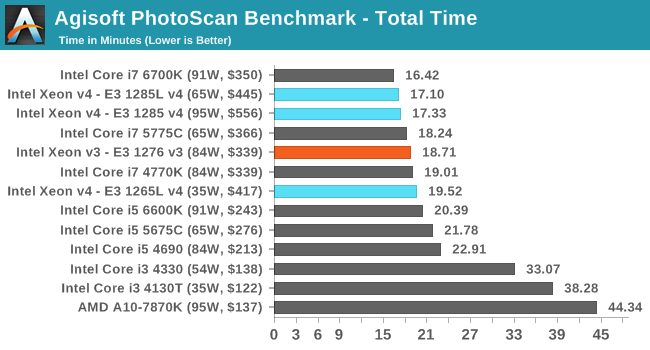
The benefits of the eDRAM here afford nearly two minutes over the v3.
Cinebench R15
Cinebench is a benchmark based around Cinema 4D, and is fairly well known among enthusiasts for stressing the CPU for a provided workload. Results are given as a score, where higher is better.
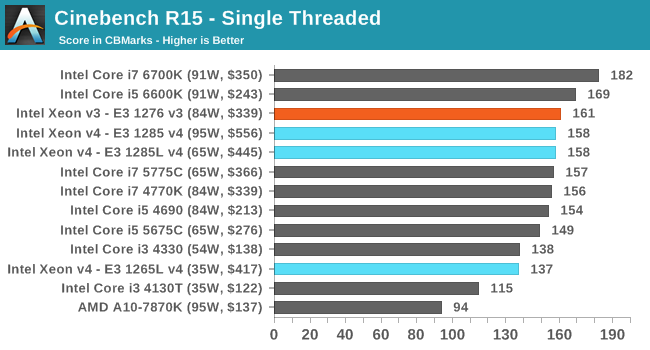

We've seen that Broadwell can organise threads slightly better than Haswell, along with its IPC increases and ability to manage more data in its buffers. As a result, while single thread is pretty much par for the course between the v3 and v4, the multithreaded result puts the v4 ahead of the v3.
HandBrake v0.9.9: link
For HandBrake, we take two videos (a 2h20 640x266 DVD rip and a 10min double UHD 3840x4320 animation short) and convert them to x264 format in an MP4 container. Results are given in terms of the frames per second processed, and HandBrake uses as many threads as possible.
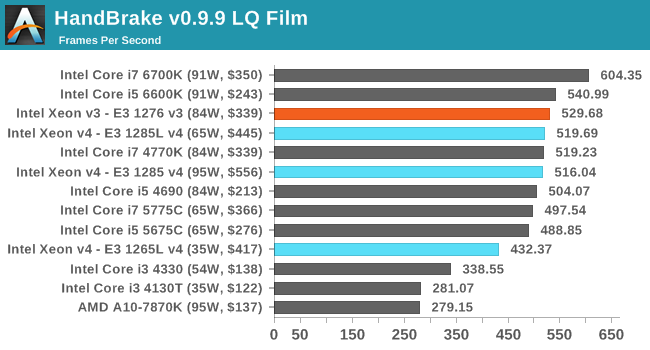
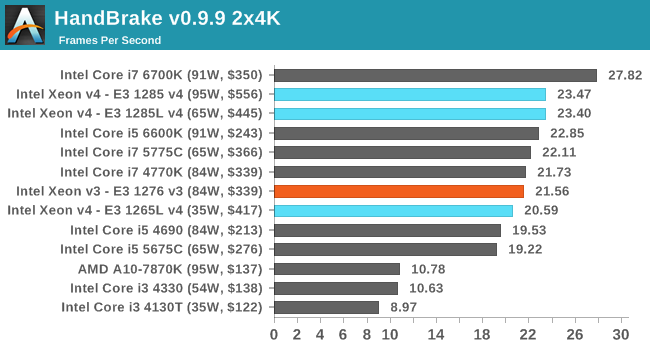
With our HandBrake tests, historically low quality encodes with small frames require a purely faster processor, whereas large high quality frames need more memory accesses. This is why the E3 v3 at 84W and E3 v4 at 35W come out near similar - the eDRAM of the v4 helps push a little ahead here. That being said, the improvements in Skylake show what perhaps the future v5 Xeons might be capable of.
Hybrid x265
Hybrid is a new benchmark, where we take a 4K 1500 frame video and convert it into an x265 format without audio. Results are given in frames per second.
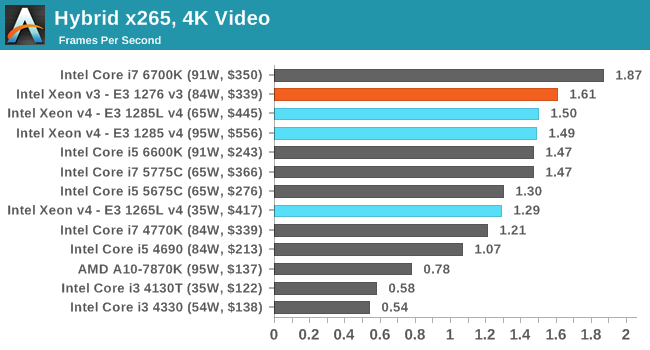










72 Comments
View All Comments
runciterassociates - Wednesday, August 26, 2015 - link
This is a server chip. Why are you benchmarking games?Furthermore, for SPEC, why are you using a dGPU when this chip has on die graphics?
Where are the OpenCL, OpenMP, GPGPU benchmarks, which are going to be the majority of how these will be used for green heterogeneous computing?
Gigaplex - Wednesday, August 26, 2015 - link
The E3 Xeons are more likely to be used in a workstation than a server.TallestJon96 - Wednesday, August 26, 2015 - link
They benchmark games because ignorant gamers (like myself) love to see gaming benchmarks for everything, even if they will never be used for games! If it was a 20 core Xeon clocked at 2ghz with hyper threading, we would want the benchmarks, even though they just show that everything i5 and up performs identically. We are a strange species, and you should not waste your time trying to understand us.Oxford Guy - Wednesday, August 26, 2015 - link
No benchmarks are irrelevant when they involve products people are using today. Gaming benchmarks are practical. However, that doesn't mean charts are necessarily well-considered, such as with how this site refuses to include a 4.5 GHz FX chip (or any FX chip) and instead only includes weaker APUs.Ian Cutress - Thursday, August 27, 2015 - link
As listed in a couple of sections of the review, this is because Broadwell-H on the desktop does not have an equivalent 84W part for previous generations and this allows us, perhaps somewhat academically, so see if there ends up being a gaming difference between Broadwell and Haswell at the higher power consumption levels.Jaybus - Friday, August 28, 2015 - link
Because, as stated in the article, the Ubuntu Live CD kernel was a fail for these new processors, so they couldn't run the Linux stuff.Voldenuit - Wednesday, August 26, 2015 - link
SPECviewperf on a desktop card?I'd be interested to see if a Quadro or FirePro would open up the gap between the CPUs.
mapesdhs - Thursday, August 27, 2015 - link
I was wondering that too; desktop cards get high numbers for Viewperf 12 because they cheat in the driver layer on image quality. SPEC testing should be done with pro cards where the relevance is more sensible. The situation is worse now because both GPU makers have fiddled with their drivers to be more relevant to consumer cards. Contrast how Viewperf 12 behaves with desktop cards to the performance spread observed with Viewperf 11, the differences are enormous.For example, tesing a 980 vs. a Quadro k5000 with Viewperf 11 and 12, the 980 is 3X faster than the K5000 for Viewperf 12, whereas the K5000 is 6x faster than the 980 for Viewperf 11. More than an order of magnitude performance shift just by using the newer test suite?? I have been told by tech site people elsewhere that the reason is changes to drivers and the use of much less image quality on consumer cards. Either way, it makes a nonsense of the usefulness of Viewperf if this is what's going on now. Otherwise, someone has to explain why the 980 compares so differently to a K5000 for Viewperf 11.
Ian Cutress - Thursday, August 27, 2015 - link
Both points noted. I'll see what I can do to obtain the professional cards.XZerg - Wednesday, August 26, 2015 - link
The gaming charts are messed up - igp performs faster than the dgpu on the SAME settings? i think something is wrong - most likely the labels of settings.Also it would have been better to compare IGP performance against the older versions of IRIS - where is 4770R? the point here is that while keeping the W similar, what are we really getting out of 14nm?